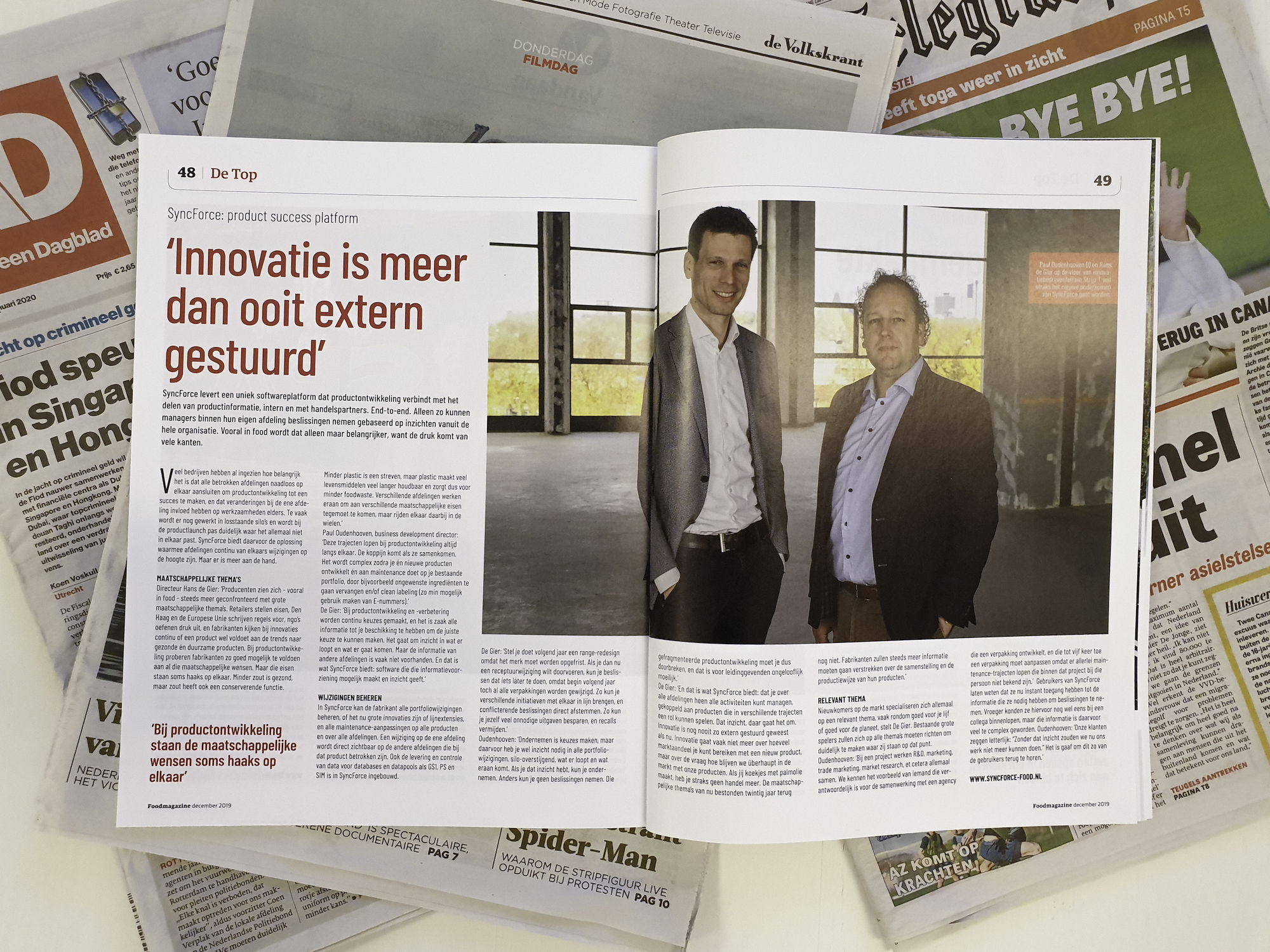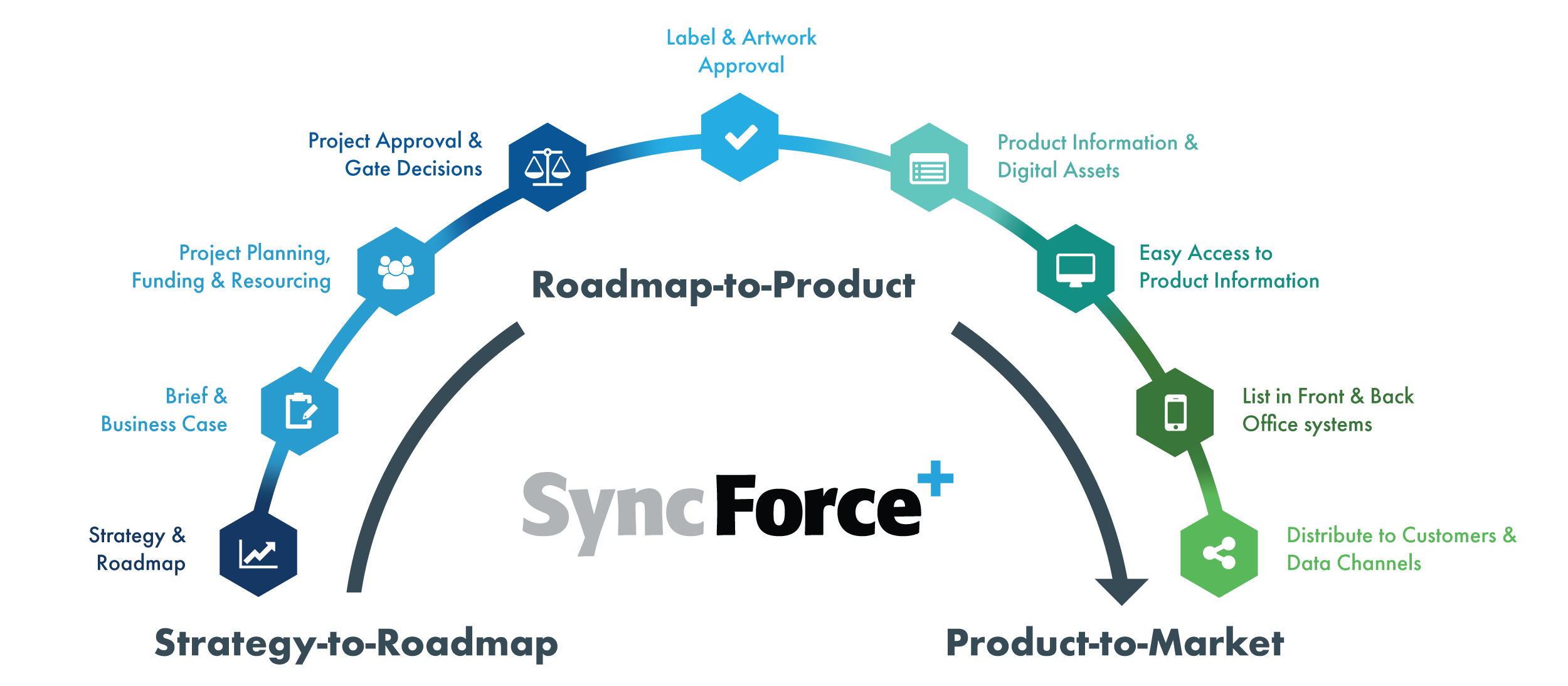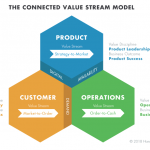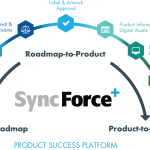Recently, Hans de Gier and Paul Oudenhooven were interviewed by the Dutch Food Magazine. The topic: the internal struggle called information management and the many external pressures that force companies to continuously innovate. Here is an English outline of the interview.

‘SyncForce provides a unique software platform; it links product development management to product information, which is managed and shared both internally and externally, with trading partners. It’s end-to-end. The company’s philosophy is that this is the only way for managers to make decisions within their own departments based on insights from the entire organization. It’s only becoming more important, especially in food, which is under pressure from several sides.’
Silos
Many companies have, in one way or the other, come to realize how important it is for product development success that all departments seamlessly connect to each other. After all, changes in one department affect activities elsewhere. Too often, however, work is still carried out in silos. Only when the product is launched do you realize that everything does not fit together and you’re dealing with multiple versions of the truth. SyncForce offers a solution that allows departments to keep abreast of each other’s changes – at all times.
But there’s more.
CEO Hans de Gier says: “Manufacturers – especially in food – are increasingly confronted with major social issues. Retailers set requirements. National governments and the European Union lay down rules. NGOs put pressure on them. All this means that manufacturers need to continuously check to see if a product meets the trends towards health and sustainability. In product development, manufacturers try to answer societal trends as well. But these requirements are sometimes at odds with each other. Less salt is healthy, but salt also has a preservative function. Less plastic is the goal, but plastic makes many food products much more durable, resulting in less food waste. Different departments are working to meet different requirements, but they are getting in each other’s way.”

Information is hard to access
It’s easier to understand the full context of a decision if its scope is fairly limited. CEOs of small – and therefore agile – organizations work closely together as one team. People in marketing, R&D, finance, and logistics probably even share a lunch table. For the CEO of a multi-billion FMCG manufacturer, however, it’s exceptionally difficult to keep an ear to the ground across the entire company. Sure, the CMO regularly reports on developments in their department; so will every other manager. But it’s all second- or third-hand information. In reality, large enterprises develop into a series of silos, each organized around their own standards and processes. It can be mind-blowingly difficult to have instant access to all the relevant information across each group that you need in order to make the best decision.
Clean labelling
Paul Oudenhooven, business development director at SyncForce, adds: “These processes always run alongside each other in product development. When they come together, they give you a headache. It becomes complex to develop new products or maintain your existing portfolio, for example by replacing undesirable ingredients and/or clean labelling (using as few E-numbers as possible).”
De Gier continues: ‘With product development and improvement, choices are continuously being made, and it is important to have all the information you need to make the right choice. It’s all about understanding what’s going on and what’s coming. But the information from other departments is often not available. And that is what SyncForce offers: software that makes the provision of information possible and provides insight. In SyncForce, the manufacturer can manage all portfolio changes, whether they are major innovations or line extensions, and all maintenance adjustments on all products and across all departments. A change in one department is immediately visible in the other departments involved in that product. The delivery and control of data for databases and data pools is also built into SyncForce.”
Avoiding recalls
De Gier comments: “Imagine you want to do a range redesign next year because the brand needs to be refreshed. If you want to make a recipe change now, you can decide to do it a little bit better, since the packaging will change next year anyways. In this way, you can align different initiatives and immediately coordinate conflicting decisions. You can save yourself a lot of unnecessary expenses and avoid recalls.”
Oudenhooven declares: “Entrepreneurship is about making choices. In order to make them, you need insight into all portfolio changes. You need to transcend silos to know what’s happening now and what’s coming next. If you have that insight, you can do business. Otherwise, you cannot make decisions. You have to break through this fragmented product development, which is incredibly difficult for managers.”
De Gier notes: “And that’s what SyncForce offers: the ability to manage all activities across all departments, linked to products that can play a role in the various processes. That insight, that’s what it’s all about. Innovation has never been so externally driven as it is at this moment. Innovation is often no longer about how much market share you can achieve with a new product, but how you stay in the market with your products at all. If you make cookies with palm oil now, you’ll soon be out of business. Today’s pressing concerns simply did not exist twenty years ago. Manufacturers must provide more and more information about the composition and production methods of their products.”
Oudenhooven declares: “R&D, marketing, trade marketing, market research, and more all work together on a project. We know the example of someone who is responsible for collaborating with an agency that develops a packaging and has to adapt a packaging five times due to all kinds of maintenance projects they didn’t know about.” SyncForce users have instant access to the information they need to make sound decisions. In the past, they used to visit a colleague for this, but that information has become far too complex for this kind of information exchange. Oudenhooven finishes: “Our customers literally say: ‘Without that insight, we wouldn’t be able to do our job anymore.’ It’s cool to hear this from the users.”

